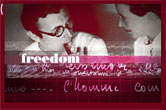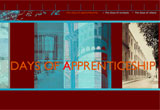Carolingian Treasures, the exhibition
The developments are discussed across several themes: the Carolingian book symbolised the power of Charlemagne and the basis of medieval culture; the specificities of the Carolingian setting; the Caroline script; the Carolingian Renaissance; reading and writing under Charlemagne. Three emblematic manuscripts can be perused in the form of digital facsimile: the Gellone Sacramentary in the Merovingian style, the Drogon Sacramentary with its amazing historiated initials and the Poems of Prudence. Finally, the references – chronology, glossary, anthology, bibliography –, notes and educational suggestions are provided for the use of internet users, teachers and pupils.
Torah, Bible, Koran: the exhibition
Comics before Comics, the exhibition
China, Empire of the Brush Stroke: the exhibition
The Art of the Arabic Book, the exhibition
Masters of the European Comic Strip, the exhibition
Persian Splendours, the exhibition
The Legend of King Arthur, the exhibition
Children's Books, the exhibition
Homer, in the footsteps of Ulysses: the exhibition
Sartre, the exhibition
Émile Zola's Ladies’ Paradise: the exhibition
Émile Zola, the exhibition
Victor Hugo, the Ocean-Man: the exhibition
Fairy Tales, the exhibition
Marcel Proust, Writing and the Arts: the exhibition
The 14-18 War, the exhibition
Games for Princes and Paupers, the exhibition
Heroes, from Achilles to Zidane, the exhibition
Enlightenment – a Heritage for Tomorrow : the exhibition
Medieval Bestiary, the exhibition
The Bestiary is divided up by type of animal, through iconographic pages and audio-visuals. There are also games and educational demonstrations for providing teachers with different ideas: the Roman de Renart (The Reynard Novel) and the universe of fables; the bestiary or the sanctimonious role of a universe of animals designed to be like man; hybrid animals and other fabulous animals. There is also a game which allows children to create their own monster and to give it features like medieval bestiaries; another, to explore all the expressions of the French language which are based on animal figures.
The sea, Terror and Fascination: the exhibition
Fouquet, Painter and Illuminator of the XVth century, the exhibition
Utopia, the Quest for the Ideal Society in the Western World, the exhibition
Medieval Gastronomy, the exhibition
Gustave Doré, the Imagination in Control: the exhibition
Illuminations of the Islamic World, the exhibition
Japanese Prints, the exhibition
Daumier & his Heirs, the exhibition
Rembrandt. The light from the shadow, the exhibition
Red, the History of a Color, the exhibition
Abraham Bosse, the exhibition
Renaissance Drawings, the exhibition
Berlioz, the Voice of Romanticism, the exhibition
Graphic Design, the exhibition
Rodolphe Bresdin, the exhibition
Face to Face, or the Art of the Portrait: the exhibition
Michael Kenna, the exhibition
Photographic Treasures of the Geographical society, the exhibition
Eugène Atget, the exhibition
The site contains nearly 800 photographs among the approximately 4,500 photographs from Atget which are kept at the BnF. It has a virtual exhibition, a feature and thematic albums that bear witness to a view so personal that the work photographer has gradually migrated from the documentary sphere to the realm of photographic art. The city of today, between the 20th and 21st century, also contains its mutations, its side-lining, its signs with their meanings, its "odd jobs". An educational feature examines the natural link between the photographer of the nineteenth century and the views of contemporary artists, sculptors, photographers, and writers so as to provide an understanding on today’s city by revisiting the themes of Atget.
The Universal Exhibitions in Paris, 1867-1900: the exhibition
Agence France-Presse, 1944-2004: the exhibition
Photographers for the Emperor – the albums of Napoleon III: the exhibition
The orders that Napoleon III gave to the photographers of his time reveal an emperor aware of the notoriety that was his for the taking. The "Power and photography" feature looks at the relationship between photography and political ambition. 141 images classified by theme describe the France of this era and its ambitions in the world: its imperial palaces, its great construction projects, distant explorations, wars and peace, Italian campaign...
Portraits / Faces, the exhibition
Gustave Le Gray, the exhibition
Traveling in the Orient, the exhibition
Nautical maps, the exhibition
The history of cartography, the exhibition
The Globes of the Sun King, the exhibition
Heaven & Earth, the exhibition

















































